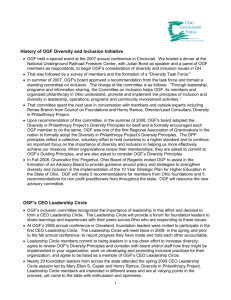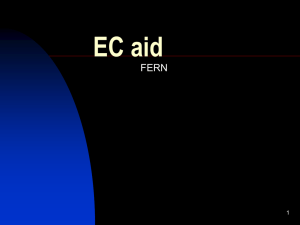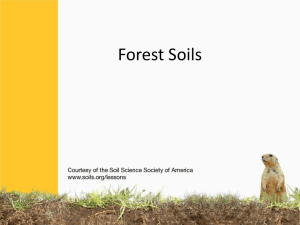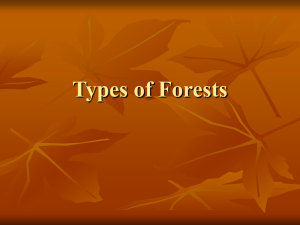Comparison of Structural Attributes between Old-Growth and
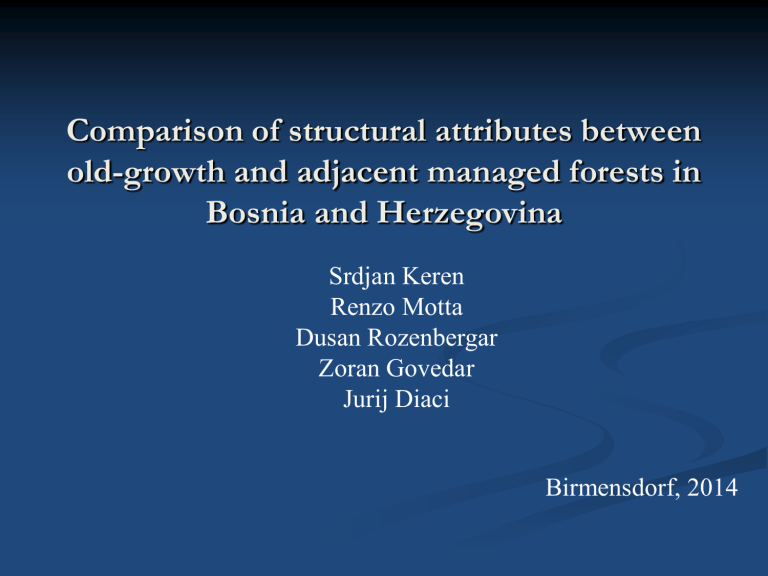
Comparison of structural attributes between old-growth and adjacent managed forests in
Bosnia and Herzegovina
Srdjan Keren
Renzo Motta
Dusan Rozenbergar
Zoran Govedar
Jurij Diaci
Birmensdorf, 2014
Introduction
Mixed forests composed of Fagus sylvatica L., Abies
alba Mill and Picea abies L.H. Karst represent ecologically and economically most important forest category in Bosnia and Herzegovina.
Of special interest to scientific community are also three wide-known mixed old-growth forests (OGF):
Perucica, Lom and Janj.
Introduction
An important aspect of sustainability verification is a comparison of managed forests with unmanaged references.
Specific objectives of this study were to test for differences in terms of: tree density, dbh distribution shapes, tree species composition, mean diameters, BA, growing stock and CWD.
Materials and methods
The research was carried out in old-growth forests Janj and
Lom and ten adjacent managed stands (by five on both sites), which are located on mountainous massifs of central and western Bosnia and Herzegovina.
Area
Geografic position
Bedrock
Altitude a.s.l.
Mean annual rainfall
Mean ann. temperature
Year of measurement
Plant association
OGF Janj OGF Lom
57.2 ha (core area)
44°08' N, 17°17' E dolomite
1240 – 1400 m
1200 mm
55.8 ha (core area)
44° 27' N, 16°28' E limestone
1250 – 1522 m
1600 mm
5.0 °C
2011
3.5 °C
2011
Piceo-Abieti-Fagetum Piceo-Abieti-Fagetum
Measurements
Regular 100x100 m grid of sampling plots was superimposed (total 80 plots in OG forests and 120 plots in managed forests).
Following inventories were carried out: in circular plots (r = 12 m) species dbh for all living trees above 7,5 cm were measured. Heights of living trees were measured for a sample of 100 trees for each species
(spruce, fir, and beech). In smaller inner plots (r = 5 m) species and height of regeneration individuals from 10 cm height to 7,5 cm dbh were tallied.
Figure 2. Outline of sample plot and subplots
Measurements
CWD measurements were carried out on two 50 m line intersect oriented northward (the first) and eastward (the second) from the centre of the sampling point.
Results
Tree densities (N/ha)
Statistics
OGF Janj MF Janj OGF Lom MF Lom
Mean 516.4
681.5
489.4
595.6
Std. Error of Mean 24.5
Median 487.0
Std. Deviation 155.1
27.5
663.0
213.3
18.9
498.0
120.1
23.2
553.0
179.3
Range 752.0
774.0
669.0
730.0
Independent t-tests involving total means of number of trees indicated significant differences between pairs OGF Janj - MF Janj
(p = 0.0000) and OGF Lom - MF Lom (p = 0.0010), but also between MF Janj and MF Lom (p = 0.0190)
Diameter distributions (sensu Janowiak et al., 2008)
RMSE
Adj. R 2
N (dbh class)
Shape
Fir
0.03
0.99
8
MF Janj
(all five stands)
Spruce Beech Total
0.04
0.99
0.01
1.00
0.03
0.99
7 6 8
Fir
0.18
0.86
12
OGF Janj
Spruce Beech Total
0.14
0.85
0.07
0.99
0.11
0.97
11 7
RMSE
Adj. R 2
N (dbh class)
Shape
RS
0.18
0.92
9
NE
IQ RS
MF Lom
(all five stands)
0.18
0.15
0.94
0.96
9
UNI
8
CO
RS
0.16
0.96
9
IQ
UNI
0.33
0.74
12
IQ
UNI
OGF Lom
0.22
0.85
11
IQ
RS
0.04
0.99
7
RS
The best-fitting multiple regression models for dbh frequency distributions
12
RS
0.21
0.94
12
NE
Mean diameters (cm)
Statistics
OGF Janj MF Janj OGF Lom MF Lom
Mean 41.3
26.5
35.4
30.4
Std. Error of Mean
Median
Std. Deviation
1.1
41.0
7.1
0.6
25.9
4.5
0.8
35.1
5.3
0.8
29.5
5.8
Range 32.4
21.5
26.0
28.9
Independent t-tests indicated significant differences in mean diameters at p ≤ 0.05 between all possible pairs:
OGF Janj vs. MF Janj, OGF Lom vs. MF Lom,
OGF Janj vs. OGF Lom, and MF Janj vs. MF Lom.
Basal area (BA) and growing stock (GS) in studied forests
Statistics OGF Janj MF Janj OGF Lom
Mean BA ( m 2 /ha)
66.7
35.5
47.1
Mean GS ( m 3 /ha) 1215.1
498.9
763.1
MF Lom
41.5
664.3
Results of t-tests showed no significant difference in basal areas between MF Lom and OGF Lom, while between other pairs difference was statistically significant at p ≤ 0.05.
Tree species composition above 7.5 cm dbh
OGF Janj was similar to MF Janj regarding basal area composition, but very different regarding tree number composition.
OGF Lom and MF Lom differred considerably upon both criteria.
Considering composition based on tree number non-significant results were yielded for pairs OGF Janj vs. OGF Lom and MF Janj vs. MF Lom, while significant difference at p ≤ 0.05 was indicated for two pairs:
OGF Janj vs. MF Janj χ 2 = 26.77
OGF Lom vs. MF Lom χ 2 = 16.81
Considering composition based on basal area similar outcomes of testing were obtained as shown above
Replacement patterns and neighborhood effects
In all studied forests overall 14 transition matrices were calculated.
One example from OGF Janj (poles to upper story) is shown here:
Upperstory trees
Beech
Fir
Spruce
Beech
0.74
0.83
0.83
Poles
Fir
0.15
0.10
Spruce Maple
0.10
0.00
0.07
0.00
0.09
0.08
0.00
Transition probability matrices indicated domination of beech regeneration under mature trees in OGF Janj and both managed forests, whereas beech poles had potentially greatest chance to reach the upperstory in both old-growth forests. Silver fir poles were given rather high chances to replace mature trees in the upperstorey of managed forests. On the other hand, despite significant shares of Norway spruce in the upperstorey of all studied forests, regeneration and poles of this species were given low chances to replace mature trees in both old-growth and managed forests in the near future.
Coarse woody debris (m 3 /ha)
Statistics OGF Janj MF Janj OGF Lom MF Lom
Mean 386.5
75.4
327.3
62.6
Std. Error of Mean
Median
Std. Deviation
Range
26.8
389.0
169.7
731
6.8
69.3
52.4
227
20.3
316.2
128.2
490
4.2
56.2
32.9
137
Independent t-tests indicated significant differences in CWD amounts between pairs: OGF Janj vs. MF Janj (p = 0.0000) and
OGF Lom vs. MF Lom (p = 0.0000), whereas no significant difference was found between two OG forests nor between two managed forests.
CONCLUSIONS
1. Smallest dbh class contained more trees in managed forests, whereas in OG forests there was incomparably more large living trees and snags above 50 cm dbh. Nevertheless, dbh distributions in managed and OG forests Janj and Lom exhibited shapes considered to provide demographic equilibrium;
2. High growing stocks with dominant conifers in the upperstorey did not cause deviations from sustainable dbh distributions; however, the issue of regulating tree species composition came to surface.
3. Neither low-intensity disturbance in OG forests nor single tree selection system in managed forests led to sufficient recruitment of spruce in understorey and midllestorey despite significant presence of this species in the upperstorey.
4. Contrary to highly stocked OG forests, small canopy openings in managed forests made through single tree selection cutting provided small but constant share of maple.
5. If the share of spruce and maple is to be increased in these managed forests in the future, slight change in silvicultural approach may be necessary.



